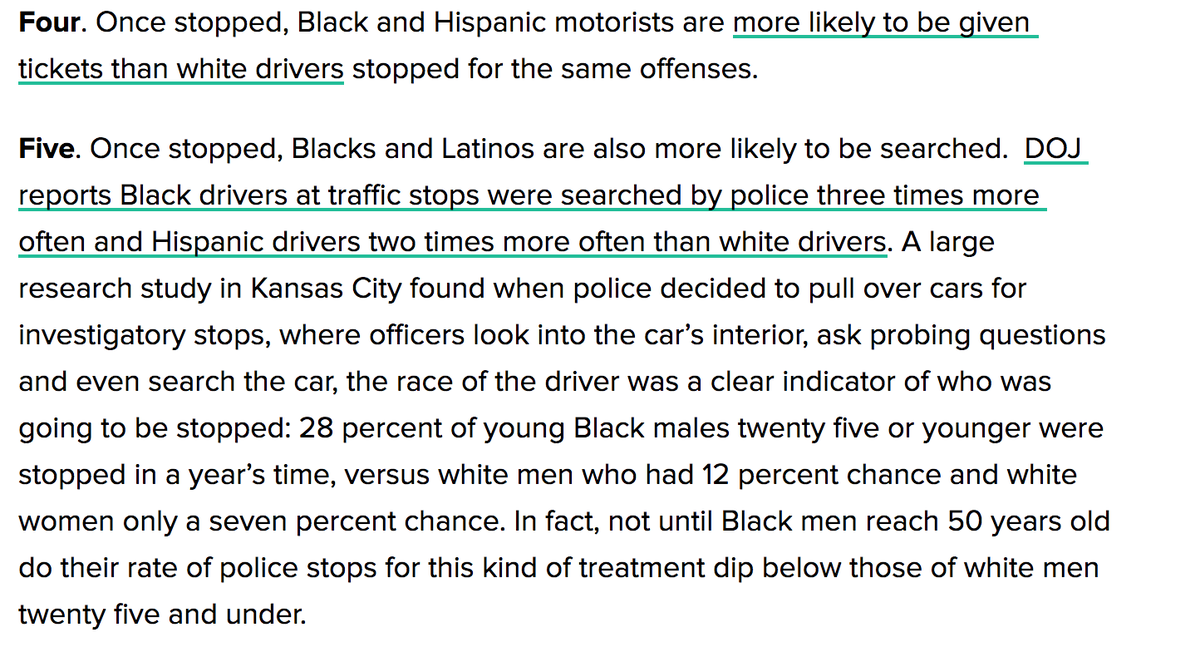Police are, ceteris paribus, 20% more likely to pull over black motorists than white, yet they find evidence of crimes, especially drugs, more among the white motorists they pull over. The ceteris paribus is deceptive here tho, bc black neighborhoods are policed more at baseline https://twitter.com/Donttagmeback/status/1198348519368744960">https://twitter.com/Donttagme...
1. Police are, ceteris paribus, more likely to stop, search, arrest, & use force against people of color, regardless the neighborhood
2. Police disproportionately patrol black neighborhoods
2. Police disproportionately patrol black neighborhoods
3. Police are, ceteris paribus, more likely to stop, search, arrest, & use force against poor people, regardless the neighborhood
4. Police disproportionately patrol poor neighborhoods
5. Poverty rates are higher among poc, as are residences in poor neighborhoods
4. Police disproportionately patrol poor neighborhoods
5. Poverty rates are higher among poc, as are residences in poor neighborhoods
I cite HuffPo only out of convenience, but this article has even starker disparities. I prefer to look at the actual scholarship tho, which I will link to in a second.
https://www.huffpost.com/entry/40-reasons-why-our-jails-are-full-of-black-and-poor-people_b_7492902">https://www.huffpost.com/entry/40-...
https://www.huffpost.com/entry/40-reasons-why-our-jails-are-full-of-black-and-poor-people_b_7492902">https://www.huffpost.com/entry/40-...
So, for example, consider Fryer& #39;s publication asserting bias in force but not shootings & then his later adoption of a more nuanced position as well as this article showing the issues w conditional bias
https://scholar.harvard.edu/jfeldman/blog/roland-fryer-wrong-there-racial-bias-shootings-police
https://scholar.harvard.edu/jfeldman/... href=" https://www.nber.org/papers/w22399.pdf
https://www.nber.org/papers/w2... href=" https://scholar.harvard.edu/files/fryer/files/fryer_police_aer.pdf">https://scholar.harvard.edu/files/fry...
https://scholar.harvard.edu/jfeldman/blog/roland-fryer-wrong-there-racial-bias-shootings-police
I already posted these: https://twitter.com/yungneocon/status/1198345145411878912">https://twitter.com/yungneoco...
At each link the chain--space, policing, patrols, race, poverty, arrests--there is a disproportionate excess of stopping, searching, arresting, use of force, charging, convicting & sentencing.
Since these variables aren& #39;t independent of each other, statistics that, for example, control for poverty to argue there isn& #39;t racial discrimination miss the point (altho, as explained, even when one controls for that disproportionate statistics linger).
At every step in the chain, the statistics are disproportionate to the:
1. proportion of the group of people in the population
2. the proportion of the crime rate baseline
3. the proportion of successful discovery of a crime
1. proportion of the group of people in the population
2. the proportion of the crime rate baseline
3. the proportion of successful discovery of a crime
If there are several links in the chain--crime, investigation (patrol, stop, or formal investigation, followed by a search etc, each w its own), arrest, charge & conviction--and several independent sources of disproportionality (poverty, race, geography, gender etc)
This means that crime report data, aggregated from police statistics, newspaper reports, arrest records, and imprisonment data, will *always* vastly over-represent some groups relative to their rate, and vastly under-represent others.
Now, one might think that victimization surveys are therefore the better bet. Usually the victimization surveys are used with the above to triangulate the data. But even these are sketchy for all the reasons surveys normally are. That said, these are less disproportionate.
The fact is that when one controls for income & wealth of the individual, their household & their neighborhood, as well as for spatial features, geography, education, & so on, then racial disparities in criminal offense disappear.
But even when you control for all of the above, racial disparities in stops, searches, arrests, charges, & convictions do NOT disappear. However small at each stage, sometimes only around 7% tho very statistically significant, this adds up.
If each stage only has a 1% (albeit robust) disproportion, when controlling for all of the above (including crime rates!), that still translates to a 5% disparity at the end of it, but actually it& #39;s self compounding through various mechanisms.
In reality, the sum total of the disparities are going to add up to something like 20%-40% and that is *again* controlling for poverty/income/wealth, geography, policing, and the crime rate.
Thus, it is plain to see that while poverty, income, geography, and policing explain away ALL of the racial disparities in criminal offense, they do not explain all the disparities in stop, search, arrest, charge, conviction & sentencing.
Since the correlation of poverty & race, *especially* on a post-tax household income neighborhood level (i.e. the spatial dimension), what& #39;s called spatial stratification, itself provably reflects racism & so on, this all understates racial discrimination.
Thus, disparities in offense rates are OVER-stated, RELATIVE TO A BASELINE, WHICH WHEN CONTROLLED FOR, THEY DISAPPEAR, while disparities in arrest etc rates are UNDER stated, RELATIVE TO A BASELINE, WHICH WHEN CONTROLLED FOR, THEY DO NOT DISAPPEAR. Rly makes you think,,,

 Read on Twitter
Read on Twitter




